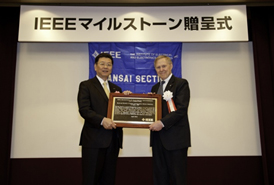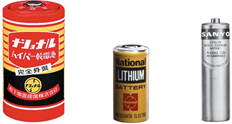Osaka, Japan - On April 12, 2014, Panasonic Corporation was recognized by the Institute of Electrical and Electronics Engineers (IEEE), the largest organization of its kind in the world, as one of the companies that has contributed to the creation and development of primary and secondary battery industries in Japan, in the IEEE Milestone titled "Birth and Growth of Primary and Secondary Battery Industries in Japan, 1893."
The IEEE Milestone program was established in 1983 to honor technical achievements that have made historical contributions to humanity and industrial development in the fields of electrical, electronic, information and communication technologies. Milestones are presented at least 25 years after the technical achievement. The aim is to enhance society's understanding and recognition of these outstanding technologies and the engineers that have produced them.
Panasonic's contributions in the fields of dry batteries, lithium primary batteries, and nickel-cadmium (Ni-Cd) batteries in Japan have been recognized by the IEEE. This is the first time the company has received appraisal under an IEEE Milestone, and marks the 19th time a Japanese achievement has been recognized.
Panasonic began with in-house production of manganese dry batteries in 1931. It then developed and commercialized alkaline dry and lithium primary batteries, taking the lead in primary battery market.
In 1954, Panasonic succeeded in developing Japan's first manganese dry battery with a fully metal-jacket, which contributed to the improvement of safety and usability. In addition to flashlights, the main application for this battery, Panasonic developed other products in which these batteries could be used, such as gas lighters, battery-powered clocks, and bathtub buzzers. This helped to increase demand.
In 1971, Panasonic was the first in the industry to develop lithium primary batteries. This enabled communication equipment to operate longer, along with the development of calculators and digital watches that were more compact and streamlined.
In 1958, Panasonic started full-scale production of Ni-Cd secondary batteries. This helped to create and expand the market for cordless equipment such as shavers, camcorders, and power tools.
These batteries have undergone continual technology advancement to the present day, and are used in a wide variety of applications from household devices to industrial equipment. Panasonic will keep contributing to society and industry by improving the convenience and performance for battery products, which are indispensable in mobile devices.
Title on IEEE Milestone plaque
"Birth and Growth of Primary and Secondary Battery Industries in Japan, 1893"
Recipients
Yai Dry Battery Limited Partnership Company, "Invention of the dry battery"
GS Yuasa Corporation, "Lead-acid battery"
Panasonic Corporation, "Dry, lithium primary, and Ni-Cd batteries"
Reason
Yai Dry Battery Limited Partnership Company received a patent for Yai's battery invention in 1893, giving birth to the Japanese dry battery industry, and contributing to its growth. Following this success, GS Yuasa Corporation and Panasonic Corporation pioneered a huge market of both primary and secondary batteries installed in industrial equipment and in home appliances. It advanced Japanese battery industries and consumer electronics.
 |
 |
IEEE Milestone presentation ceremony
(From left) Mr. Ito, President of AIS Company, Panasonic Corporation, Dr. Staecker, former Chairman of the IEEE |
Panasonic's dry, lithium primary, and nickel-cadmium batteries of an early date |
About Panasonic's Batteries
Dry Batteries
Features: Produced in 11 countries worldwide, and sold mainly as a commercially available dry battery. Top market share in Japan.
History:
1931 Started in-house production of manganese dry batteries in Osaka
1954 Released "National Hyper" the first fully metal-jacketed manganese dry battery in Japan
1963 Released "National Hi-Top" manganese dry batteries
1967 Released alkaline dry batteries
1991 Released mercury-free manganese dry batteries
1992 Released mercury-free alkaline dry batteries
2008 Released "Evolta" alkaline dry batteries
2010 Achieved a cumulative production of 150 billion dry batteries
2011 Released "Evolta" alkaline dry batteries adopting anti-leak protection
Lithium Primary Batteries
Features: A wide operating temperature range, and developed mainly for commercial use. Applications include back-up power supplies for electronic meters and mobile devices. Top share of the global market.
History:
1971 Developed poly carbon-monofluoride lithium primary batteries
1976 Released pin type Lithium primary batteries for electric fishing floats
1985 Released Lithium pack batteries for cameras
1999 Developed ultra slim coin-type manganese dioxide lithium batteries (CR series)
2001 Achieved a cumulative production of one billion cylindrical lithium batteries in Japan
2010 The asteroid explorer "Hayabusa" returned to the earth (Panasonic cylindrical lithium primary batteries were adopted in the recovery capsule)
Ni-Cd Batteries
Features: High power and durability, and used for power tool and emergency lighting. Top share of the global market for professional power tools.
History:
1958 Started full-scale production of Ni-Cd batteries
1961 Developed and released the first button type Ni-Cd battery in Japan
1964 Started production of "Cadnica" sealed Ni-Cd batteries
1965 Released "Cadnica Light" aiming to create and grow Ni-Cd battery markets
1964 Developed spiral structure "Cadnica" Ni-Cd batteries which realize high rate discharge
1970 Developed and released "Pananica" sealed Ni-Cd batteries
1971 Released emergency use "Pananica" which realize trickle charge at high temperature
1974 Developed high power "Cadnica" adopting tab-less current collection structure
1994 The H2 rocket, Japan's first all-domestically produced large rocket, was launched ("Cadnica" batteries were adopted in the satellite)
2005 Achieved a cumulative production of 15 billion Ni-Cd batteries globally
2013 Developed "Cadnica GT series" Ni-Cd batteries which operable at minus 40°C
About Panasonic
Panasonic Corporation is a worldwide leader in the development and engineering of electronic technologies and solutions for customers in residential, non-residential, mobility and personal applications. Since its founding in 1918, the company has expanded globally and now operates over 500 consolidated companies worldwide, recording consolidated net sales of 7.30 trillion yen for the year ended March 31, 2013. Committed to pursuing new value through innovation across divisional lines, the company strives to create a better life and a better world for its customers. For more information about Panasonic, please visit the company's website at http://panasonic.net/.
Media Contacts:
- Public Relations Development Office
Panasonic Corporation - Tel: +81-(0)3-3574-5664 Fax: +81-(0)3-3574-5699
- Panasonic News Bureau
- Tel: +81-(0)3-3542-6205 Fax: +81-(0)3-3542-9018






